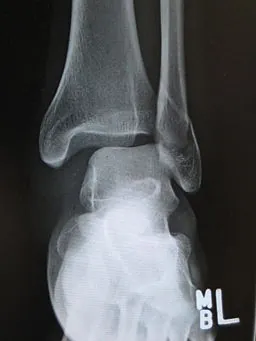A fracture of the ankle may occur to a person involved in a motor vehicle collision. A fracture involving the talus, a bone that makes up the lowest part of the ankle joint, is usually apparent in people involved in a motor vehicle collision. Notwithstanding, this injury can also be seen in victims of falls or snowboarders.
The talus is plays a large role in connecting the foot, leg and body. This particular part of the ankle also helps us transfer weight and pressure evenly across the ankle.
How do I know if I have a fracture of the talus? Generally, a person will experience severe pain and will find that their ankle is unable to bear weight. There may be visible swelling and the area may be tender to touch. Usually, the diagnosis of a fracture will be made at the first visit.
However, there have been times when the injury may be diagnosed as an ankle sprain due to the tenderness and especially if there is bruising at the site. The severe pain usually prompts the person to return quickly to their doctor or local emergency room where radiological imaging or tests will be performed next to determine if there is a fracture.
If a person is seen in the ER shortly after this injury occurs, the attending physician will most likely order an x-ray or CT scan which may help the doctor diagnose a fracture. At times a second visit may be required as not all x-rays clearly demonstrate fracture. A CT scan will be ordered which evidences fractures clearer than x-rays.
The doctor will use the films to determine the next course of action. The doctor will also be interested in knowing if the bones are aligned (a nondisplaced fracture) or if the bones have shifted (a displaced fracture).
Depending on the severity of the fracture, the physician will determine if it can be treated surgically or non-surgically.
If the physician determines it can be treated non-surgically, he will put the ankle in a cast and order that no weight be placed on the ankle for 6 to 8 weeks. If a non-surgical approach is chosen, this means that the bones remain aligned. Afterwards the physician may provide exercises to help the ankle become mobile again or a referral may be made for physical therapy. In addition to the ankle losing some mobility, the foot will have also lost mobility due to non-use while in a cast.
However in many cases an individual who sustained a talar fracture will find that their doctor orders surgery. If this occurs, it is because the bones are not aligned. During the surgery, the bones will be realigned using metal screws. Sometimes, there is bone debris which will need to be removed. A graft may also be done to help restore integrity to the area.
If the ankle undergoes surgery, the foot will be placed in a cast for 6 to 8 weeks. Doctors will advise you to refrain from putting weight on the foot. MRI’s may be taken to ensure the area receives sufficient blood supply to prevent further injury.
Unfortunately, talar fractures often cause the person to have persistent pain and stiffness due to the damage the cartilage sustained. (The talus is covered cartilage which is why it frequently gets damaged with this injury.) Additionally, the injured area may experience arthritis later.
If you have experienced a talar fracture after a fall, motor vehicle accident or other traumatic event, please call my office for a free consultation. My office, the Edward A Smith Law Offices, has successfully resolved severe injury claims since 1989. Please learn about our successful cases and verdicts which I have posted on our website. You can get acquainted with my team through my website, www.AutoAccident.com or by calling us at (916) 921-6400. Look at AVVO, Google, Facebook or Yelp to see past client reviews.
Photo Attribution: By James Heilman, MD (Own work) [CC BY-SA 3.0 (http://creativecommons.org/licenses/by-sa/3.0) or GFDL (http://www.gnu.org/copyleft/fdl.html)], via Wikimedia Commons

